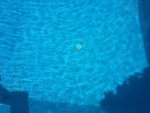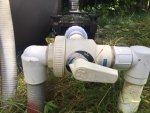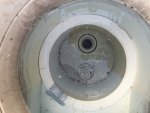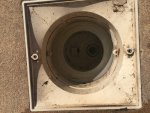Hi Everyone,
I bought a house with an inground pool 2 years ago, and for the most part, I think I understand the equipment around the pool.
One thing I'm most confused about is the main drain/return (shown below). I had a local pool professional out last year to close the pool, and he mentioned that the main drain wasn't hooked up. I think he was attempting to lower the water using the main drain, and had to use his own pump instead. I wish I asked more detail at the time, but it didn't really occur to me to ask what that meant.

When the pump is running, it does return water, along with a single wall return in the shallow end.
I have never witnessed it appear to take in water. But I don't know if I've ever truly isolated the drain to see if it can. Below is the valve for the intakes:

The pool has two skimmers (1 at the shallow end and 1 at the deep end). Both are functioning properly at this setting. I can switch the valves to verify that both of them can take in water independently.
So here are my questions:
1. If the main drain/return were actually functioning as a drain, would I see another port in this valve for the drain?
2. Could the main drain be connected to the same port as one of the skimmers?
3. Is there a way to isolate the main drain to see if it's actually connected to work as a drain?
4. Do dual purpose fixtures (main drain/bottom return) actually exist? or am i confusing the two?
I'm really looking to determine what this fixture does (whether a main drain, bottom return, or both) and if it can function as a main drain, is it broken? or was it never hooked up that way?
Thanks in advance!
Dave
I bought a house with an inground pool 2 years ago, and for the most part, I think I understand the equipment around the pool.
One thing I'm most confused about is the main drain/return (shown below). I had a local pool professional out last year to close the pool, and he mentioned that the main drain wasn't hooked up. I think he was attempting to lower the water using the main drain, and had to use his own pump instead. I wish I asked more detail at the time, but it didn't really occur to me to ask what that meant.

When the pump is running, it does return water, along with a single wall return in the shallow end.
I have never witnessed it appear to take in water. But I don't know if I've ever truly isolated the drain to see if it can. Below is the valve for the intakes:

The pool has two skimmers (1 at the shallow end and 1 at the deep end). Both are functioning properly at this setting. I can switch the valves to verify that both of them can take in water independently.
So here are my questions:
1. If the main drain/return were actually functioning as a drain, would I see another port in this valve for the drain?
2. Could the main drain be connected to the same port as one of the skimmers?
3. Is there a way to isolate the main drain to see if it's actually connected to work as a drain?
4. Do dual purpose fixtures (main drain/bottom return) actually exist? or am i confusing the two?
I'm really looking to determine what this fixture does (whether a main drain, bottom return, or both) and if it can function as a main drain, is it broken? or was it never hooked up that way?
Thanks in advance!
Dave




